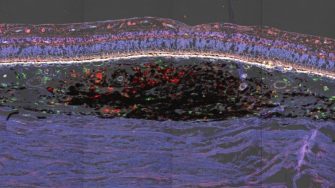
Ocular Pathology Research
Understanding normal human eye development and ageing is important for discovering the pathogenesis of human eye diseases including age-related macular degeneration (AMD), primary eye tumours, peripheral retinal degenerations and inflammatory eye diseases. We primarily study human posterior eye cell biology and microenvironment especially related to iris pigmentation, choroidal inflammation, choroidal naevi and melanoma, and retinal pigmented epithelium (RPE) growth and ageing.
We currently use a variety of laboratory techniques and approaches including culture of primary human eye cells, multimarker immunolabelling and confocal microscopy, ELISA, immunoblotting, RNA-Seq and qPCR (ANU), and advanced microscopy (2-photon and fluorescence lifetime imaging - Biomedical Imaging Facility (BMIF), UNSW). The challenge continues to be to develop innovative approaches to understanding human eye cell biology and its relationship to clinical outcomes.
Our current research projects involves collaborations with colleagues at the School of Optometry and Vision at UNSW and in other locations including the Save Sight Institute, Pharmacy, and Children’s Medical Research Institute (University of Sydney); SydPath and The Kinghorn Cancer Centre (St. Vincent’s Hospital); John Curtin School of Medical Research (The Australian National University, Canberra) and Leiden University Medical Centre (The Netherlands).
Research goals
- To investigate the cell biology of human eye melanocytes, melanogenesis and the role of melanocytes in inflammation within the eye.
- To understand the microenvironment of primary eye tumours, especially melanoma, and develop novel approaches for eye melanoma therapy. This includes studying normal human choroid, and choroidal nevus formation.
- To study the normal effects of ageing in the human retina and choroid, including central and peripheral retinal degenerations, and RPE ageing.
Current research themes
- Melanocortin Receptors in Human Choroidal Melanocytes and Melanocytic Lesions.
- Cellular and Genetic Changes in Human Choroidal Naevi.
- Human RPE-Extracellular Matrix Interactions.
- Application of Image Analysis Techniques to Assessing Eye Pigmentation and Iris Colour.

